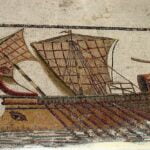Roman conquest of the Balearic Islands took place in 123 BCE. Previously, the islands were under the control of Carthage; however, from 146 BCE, when the Romans defeated the Punics, the islanders could enjoy a certain freedom.
Ancient sources indicate that the reason for the annexation of the islands by the Romans was to be the plundering expeditions of pirates who at the end of the 2nd century BCE were to have numerous bases on the rocky shores of the islands southeast of Spain. On the other hand, Strabo reports that pirates made up only a small percentage of the islanders.
Regardless of the version, it seems that Roman authorities were only looking for an excuse to subjugate the archipelago. The decision could have been greatly influenced by the fact that at that time Quintus Fabius Maximus was campaigning in the Transalpine Gaul, and the possible support from the Balearic Islands and having bases on the islands would be very helpful. The war expedition was led by consul Quintus Cecilius Metellus (later he was nicknamed “Balearic”).
The Balearic Islands were famous in ancient times for their mercenaries and excellent slingers recruited by both Carthaginian and Roman armies. The Romans already had a chance for a direct battle at sea. The Balearic people set off against the Roman fleet in much smaller boats, with which the Romans, however, had no major problems. According to Florus, a land clash would also take place; however, the struggle was not in the nature of great open air battles, but rather of stifling resistance in mountainous regions.
It is suspected that the real losses of the defenders could be about 5,000 people, because after the conquest of the archipelago, Metullus was given the right to perform the triumph, which took place in 121 BCE. After the annexation of the islands, bring about 3,000 Roman colonists. The centers of Pollentia and Palma were also founded there.







